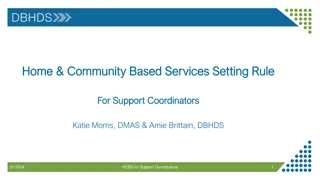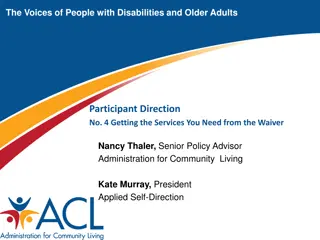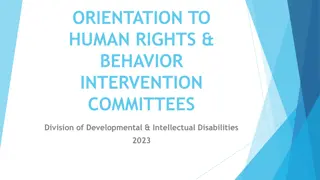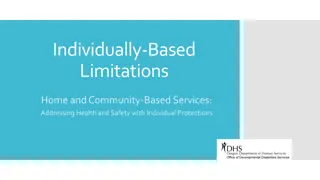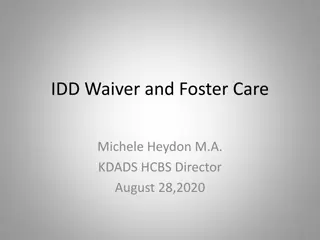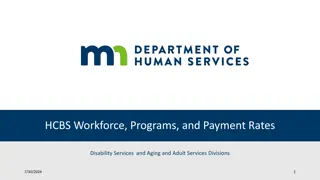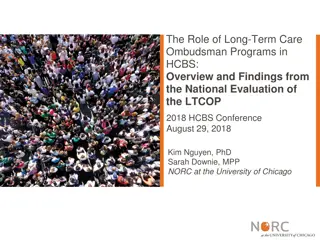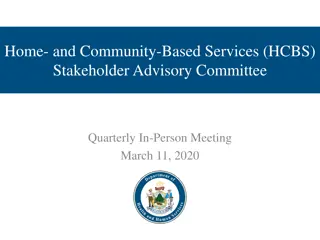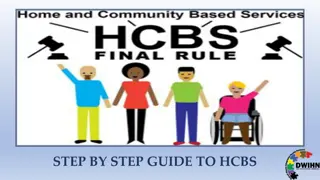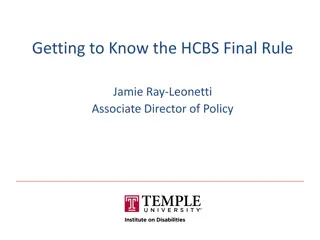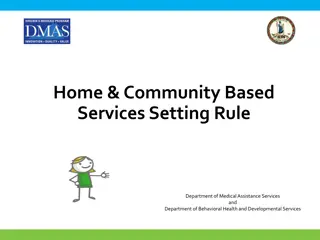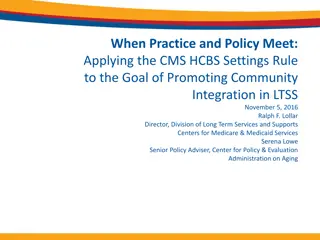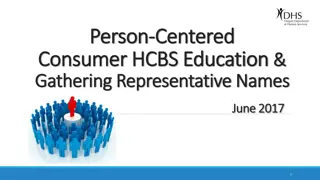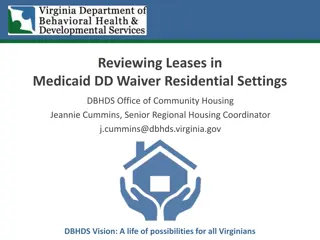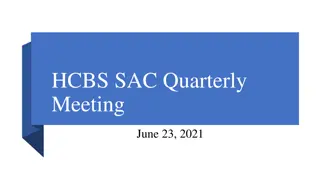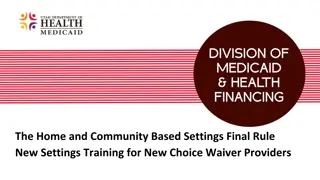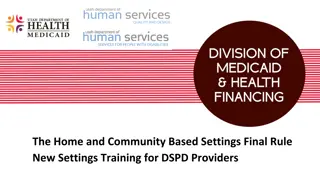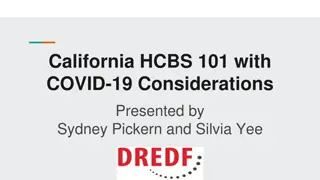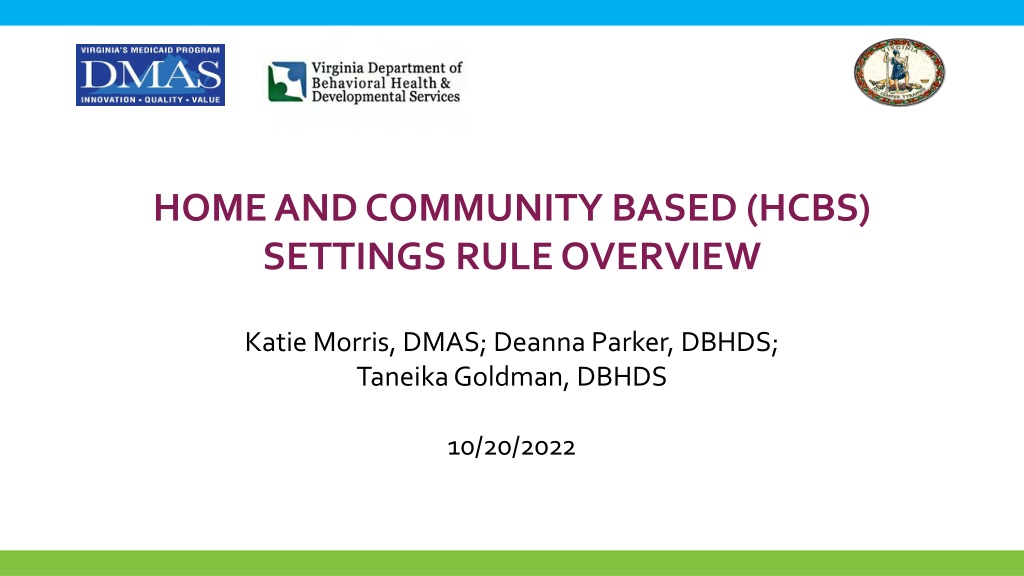
Understanding HCBS Settings Rule Overview in Virginia
Explore the Home and Community-Based Settings Rule in Virginia, its policy background, impacts on individuals, and the importance of person-centered plans. Learn about the compliance approach, specific protections, and current project status related to HCBS. Gain insights into the DD Policy, deinstitutionalization, and the significance of the Americans with Disabilities Act in promoting community-based supports.
Download Presentation

Please find below an Image/Link to download the presentation.
The content on the website is provided AS IS for your information and personal use only. It may not be sold, licensed, or shared on other websites without obtaining consent from the author. If you encounter any issues during the download, it is possible that the publisher has removed the file from their server.
You are allowed to download the files provided on this website for personal or commercial use, subject to the condition that they are used lawfully. All files are the property of their respective owners.
The content on the website is provided AS IS for your information and personal use only. It may not be sold, licensed, or shared on other websites without obtaining consent from the author.
E N D
Presentation Transcript
HOME AND COMMUNITY BASED (HCBS) SETTINGS RULE OVERVIEW Katie Morris, DMAS; Deanna Parker, DBHDS; TaneikaGoldman, DBHDS 10/20/2022
Agenda Policy Background HCBS Background Virginia s Approach to Compliance Specific HCBS Protections Person-Centered Plans HCBS and the Guardianship Code Modifications Current Project Status Questions and Answers
DD Policy and Deinstitutionalization Americans with Disabilities Act of 1990 Olmstead V. L.C. 1999 Rehabilitation Act of 1973 Supreme Court affirmed the right to state-funded supports/services in the community rather than institutions when: Community supports are appropriate; The person does not object /chooses to live in the community;; and Providing services in the community would be a reasonable accommodation when balanced with other similarly situated individuals with DD. Section 504 prohibits organizations and employers from excluding or denying individuals with disabilities an equal opportunity to receive federal program benefits and services. Guarantees that people with disabilities have the same opportunities as everyone else to participate in the mainstream of American life. Defines the rights of individuals with disabilities to participate in, and have access to, federal program benefits and services.
Why was the HCBS Settings Rule drafted? CMS answered this question with the following response: Section 1915(c) of the Social Security Act was established in 1981 to allow states opportunities to provide optional Medicaid services to individuals with chronic illness and disabilities as alternatives to institutional care. Over time, a variety of settings were developed to serve individuals in need of long-term services and supports and questions arose as to whether certain settings presented true alternatives to institutions. It became clear that CMS needed to develop rules that distinguish home and community-based settings from institutional settings. CMS is committed to ensuring that individuals served in Medicaid home and community-based programs have access to the benefits of community living and have full opportunity to be integrated in their communities.
Who does HCBS impact? CMS has the authority to apply the final rule for all individuals who receive 1915 (C, I and K) services. In Virginia, this impacts individuals who receive services from the Community Living (CL), Family and Individual Supports (FIS), Building Independence (BI) and CCC+ Waivers. Human Rights Regulations covering ALL DBHDS licensed services HCBS Services
HCBS Impacts- Deans Story Dean is a young man who has lived in several different group homes. He was regularly asked to find other residential providers due to aggressive behaviors towards the staff. Dean moved into a sponsored residential setting and was able to develop a great rapport with his staff person who focused on building independent living skills to Dean. Since learning these skills Dean can now: Stay home without support for up to 3 hours Use Uber independently Access his neighborhood and nearby stores alone Lastly, Dean no longer has aggressive behaviors as his quality of life has improved.
Virginias Path to Full Compliance Step 1: Organizational Compliance & Development of HCBS Policies Step 2: Setting Level Reviews Step 3: Ongoing Monitoring We are here
Setting is integrated & Supports Full Access to the Community Rights of Privacy Dignity, Respect & Freedom from Coercion & Restraint Values, Principles, Common Language HCBS Requirements Optimizes, but does not regiment individual initiative & autonomy Additional Conditions for Residential Settings Facilitates choice regarding services and supports and who provides them 8
HCBS Rights v DBHDS Human Rights The Human Rights Regulations assure certain rights for individuals receiving services from providers that are licensed, funded or operated by DBHDS 50-Dignity 60-Services 70-Participation in Decision Making and Consent 80-Confidentiality 90-Access to and Amendment of records 100-Restrictions on Freedoms of Everyday Life 105-Behavioral Treatment Plans 110-Use of Seclusion, Restraint or Time Out 120-Work 130-Research 145-Determination of Capacity and Authorized Representatives 150-Complaint and Fair Hearing
Specific HCBS Protections The final rule requires that all home and community-based settings meet certain qualifications. The setting must: Be integrated in and supports full access to the greater community; Be selected by the individual from among setting options; Ensure individual rights of privacy, dignity and respect, and freedom from coercion and restraint; Optimize autonomy and independence in making life choices; and Facilitate choice regarding services and who provides them.
ISP Requirements Person Centered Individual Support Plans (PCISP) for individuals must reflect the services and supports that are important for the individuals identified needs and preferences. An individual s written PCISP must: Reflect that the setting was the individual s choice and is integrated in, and supportive of full access of the individual to the greater community. Reflect the individual s strengths and preferences. Reflect clinical and support needs that have been identified through a functional needs assessment. Include individually identified desired outcomes and support activities. 11
Residential Protections The Final Rule includes additional requirements for provider-owned or controlled home and community-based residential settings. Individual s living in the setting must: Have a lease or other legally enforceable agreement providing similar protections; Have privacy in their unit including lockable doors, choice of roommates and freedom to furnish or decorate the unit; Be able to control their own schedule including access to food at any time; Be able to have visitors at any time; and Be able to physically access the setting
Lease/ResidencyAgreement All individualsin the setting must havea leaseor otherlegally enforceableagreement. The lease must: FollowtheVALandlord Tenant Act. Addressevictionprocedures. NOTbein conflict with HCBS agency policies. 13
PrivacyandLocks Privacy in roomand lockable doors. Doorsshouldhavelockswith keys,butkey padlocks areacceptable if an individual is abletouseakeypad lock. Staffand otherindividuals knock before enteringAND wait for permission toaccess. Doorscan beclosed when theindividual is in theirroom. An individual canusethephone, computer,etc.in theprivacy oftheir room with the doorclosed. 14
Bedrooms Ifa room is shared,individuals must be able to: Choose with whom theyshare theroom. Have the freedomto furnish anddecoratethe unit. Examples:bedroompaint color,bedspreads,d cor, pictures, furniture,TVs,technology,etc. 15
Bedrooms Theindividualshouldbeaskedfortheir preferencein decoratingtheroom. Iftheindividualshows nospecificinterest indecorations,the residential providershould striveto decoratethe individual s roominamannerthat fitsthe individual spersonality/interests andnot onlytheinterestsorpreferencesofthe provider,family, etc. 16
Schedules Individualsshould beableto: Wakewhen they wantand sleepwhenthey want. Choose to stay home orgoonoutings. Havethe optionto use public transportation insteadofthevan. Participateinpreferredactivitiesinand out of the home. Freedomandsupportto controlschedules andactivities. 17
AccesstoFood Individuals should: Haveaccesstofood atany time. Eat what,when, and where theywant. Havethechoiceto eat earlierorlaterthan establishedmeal times,andhaveasnackwhen theywant. 18
Visitors Individual s have the: Rightto havevisitorsat any time. Ability to haveovernightvisitors. Right to visitorsthat arenot limited to family. (i.e. friends,co-workers, andsignificant others.) Visitorsdo not needto be pre-screened. 19
Access Access to the setting includes: Havingakeytotheentrancedoorofyour home. The righttoanaccessiblehome. (i.e. abilitytoaccess all commonareas,bedroomandbathroom, as well as accessibleentrancesandexitsofthehome). Therighttoanaccessible environmentCANNOTbe modified! 20
HCBS Rights and Guardianship Code 64.2-2019 C. A guardian shall maintain sufficient contact with the incapacitated person to know of his capabilities, limitations, needs, and opportunities. The guardian shall visit the incapacitated person as often as necessary. E. A guardian shall, to the extent feasible, encourage the incapacitated person to participate in decisions, to act on his own behalf, and to develop or regain the capacity to manage personal affairs. A guardian, in making decisions, shall consider the expressed desires and personal values of the incapacitated person to the extent known and shall otherwise act in the incapacitated person's best interest and exercise reasonable care, diligence, and prudence. A guardian shall NOT unreasonably restrict an incapacitated person's ability to communicate with, visit, or interact with other persons with whom the incapacitated person has an established relationship.
HCBS Rights and the Guardianship Code Align in areas of choice, communication and autonomy. Encourage person-centered thinking by requiring the Guardian to have sufficient contact with the individual and know their needs, strengths, limitations and personal values. Encourage independence to the fullest extent possible. Ensures that individuals are able to be included in decision making.
Modifications When all options for less restrictive interventions have been tried without success to support an individual s health and safety needs, a provider can implement a modification to a residential specific right. An HCBS modification allows an individual with a documented health and safety need to be restricted from a specified HCBS right to ensure his/her safety for a period of time until the individual is able to fully exercise that right. The process for implementing a rights modifications is person- centered. It ensures that the individual fully understands and agrees to the modifications. 23
Modifications The cornerstone of HCBS is that supports that are provided in the setting, as well as any daily activities, goals, etc., are person-centered, self directed, and targeted to a specific individual in the residence. This means that ANY restrictions which are setting wide and intended for everyone in the setting, regardless of their needs, are fundamentally in conflict with HCBS. 24
Modifications Must Be Supported by specific assessed need Justified in the person-centered service plan Documented in the person-centered service plan 25
Modification Documentation The documentation to support a modification must include: A specific individualized assessed need Prior interventions and supports including less intrusive methods A description of condition proportionate to assessed need Ongoing data measuring effectiveness of modification Established time limits for periodic review of modifications The individual s informed consent Assurance that interventions and supports will not cause harm 26
DBHDS Human Rights Restriction Review/Approval Providers are permitted to implement restrictions in order to achieve a therapeutic balance between rights and health/safety Restrictions are context-dependent and must be person- centered. The more restrictive the approach, the more process the regulations require Notification to OHR and LHRC Review (prior approval in some cases) Individuals always maintain their right to due process
Alternatives to Modifications- Lucys Story Lucy is a person who has PICA and a history of eating non- food items. She lives in a residential setting and has her own room. Lucy s support team were concerned that having a key would present a health and safety risk for eating the key. Lucy s residential provider installed her a finger print door lock. She can now lock and unlock her bedroom with her fingerprint. She has independence and privacy, but is also safe. Trying alternatives to modifications is required and can lead to an alternative that fully honors HCBS Rights.
Modifications To determineifamodificationisnecessary,askthe following questions: 1. Areanyoftheresidential specificprotectionscausinga health and safetyconcernfortheindividual receiving services? 2. Haveless intrusive interventions beenused?This could include: specificstaffsupports,naturalsupports,specific services(AT,TC, etc.). 3. Willtheproposedmodification donoharmtothe individual? 4. Doestheindividual/guardian consenttoamodification? 16
Modifications Ifamodificationisrequired,itisnotexpectedtoremaininplace forever. Aproviderisrequiredtocollect dataontheinterventionand reviewthemodificationonanongoingbasis. Datacollectionandreviewmustmeasuretheongoing effectivenessofamodification. Modificationsmustbereviewedattimelimitsthatareestablished by theprovider(ex-monthly,quarterly,etc.).Atthisreview,the abilityto terminatethemodificationmustbediscussed. 30
Modifications ThemodificationmustbedocumentedintheproviderISPsection of the Waiver Management System. Themodificationprocessdoesnotnegateanyrequired HumanRights process.Pleasereachouttoyourlocal HumanRightsadvocateifyou havequestionsregarding theHumanRightsregulations. 31
ModificationSummary AmodificationshouldNOT beusedbecausetheprovider/familybelieves thattheindividualisincapableofexercising his/her/theirHCBSrights.HCBS rightsareinherent HumanRights and compliance is required to participate in the DD Waivers program. Amodificationisnottobeusedtorestrictpeoplefrom doingthingsthe provider/familyisuncomfortablewith. Amodificationisonlytobeusedforhealthandsafety reasons. Amodificationmustfollowtheprocessoutlinedinthe settingsregulation (modificationsarejustifiedand documented,withalternatives,consent given,and revisitedregularlybytheprovider.) The provider s job is to not only support individuals,but helpthemto buildskills to increase independence. 32
HCBS Rights and Guardianship Decisions The HCBS rule requires that in order for certain services to be Medicaid funded, specific requirements of the HCBS rule must be met. If an individual has a plenary guardian, the guardian has the authority to make decisions in the place of the individual. However, guardian decisions may not impair or prevent full compliance with the HCBS requirements. If agreement cannot be reached and a guardian is requesting restrictions that cannot be justified as required by the rule, the guardian risks jeopardizing the individual s HCBS Medicaid Waiver status. Any restrictions on the individuals rights, whether by a guardian or service provider at the guardian s direction, must be consistent with the HCBS rule modifications process. Any modifications must be paired with efforts to provide support to an individual to decease the need for the modification and increase their freedoms. If there is disagreement on access of an individual to certain freedoms, these issues should be discussed during the person-centered planning meeting with the goal of coming to a mutually agreeable compromise.
What if We Dont Agree? 3 2 Work to resolve issues within the scope of the state s legal/administrative authority. 1 Review guardianship orders to determine the extent of plenary authority (full, partial, public) Educate the provider and the guardian on HCBS and their respective roles.
FullCompliance Onceasettinghasachievedfullcompliance,aletterwillbesentto theprovider documenting their status. Reaching HCBS complianceisnota one-time achievement. A providermust maintaintheir compliancestatuswhichwillbe monitoredonanongoingbasis through: The DBHDSOffice of Licensing TheOfficeofHumanRights DMASQMR SupportCoordination andother qualitymonitoringreviews. Ifa setting can t reachfullcompliance,theprovider participation agreementwill bereviewed.Possible consequencesinclude suspensionofbilling,and removalofthe agreement. 35
HCBS Impacts- Ricks Story Rick lived for many years in an ICF. He transitioned into a residential setting a few years ago and the home made accommodations to the entrances, exits, bathrooms and all living areas to accommodate Rick and his equipment. With the accommodations, Rick can access his home independently (all living areas and his bedroom). He does not need to ask staff to help him move from one area to another (a freedom he did not have in the ICF). He goes into the community often and has formed a friendly bond with a local barber. He also enjoys going to cookouts, parks and shopping weekly. Rick reports being the happiest he has ever been and he has even had general health improvements since leaving the ICF.
Common Remediation Areas Use of person-first language Documentation not showing independence or choice Access to the community Modifications without following process Freedom to change schedules House/ Program Rules in direct conflict with the Rule Missing lease agreements/ missing VLTA in leases Lack of presumed competence Missing training/awareness on coercion Setting-wide restrictions
HCBSResources TheToolkitcanbelocatedontheDMASWebsite: https://www.dmas.virginia.gov/for-providers/long- term-care/waivers/home-and-community-based- services-toolkit/ 38



